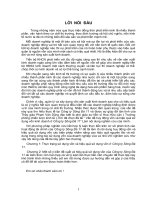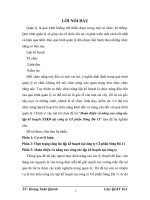lec 11 modernism
Bạn đang xem bản rút gọn của tài liệu. Xem và tải ngay bản đầy đủ của tài liệu tại đây (538.11 KB, 7 trang )
Modernism
An Overview
General Definitions
Modernism
a term typically associated with the twentieth-century reaction
against realism and romanticism within the arts. More generally,
it is often used to refer to a twentieth-century belief in the virtues
of science, technology and the planned management of social
change.
Modernity
refers to a period extending from the late sixteenth and early
seventeenth centuries (in the case of Europe) to the mid to
late twentieth century characterized by the growth and
strengthening of a specific set of social practices and ways
of doing things. It is often associated with capitalism and
notions such as progress.
A Working Definition
Modernism is a cultural movement which
rebelled against Victorian mores
Victorianism
emphasized
nationalism & cultural absolutism.
placed humans over and outside of nature.
showed a single way of looking at the world, and in
absolute and clear-cut dichotomies between right and
wrong, good and bad, and hero and villain.
saw the world as being governed by God's will, and
that each person and thing in this world had a specific
use.
A Working Definition
Modernism is a cultural movement which rebelled
against Victorian colonization views
Victorians
saw the world as neatly divided between
"civilized" and "savage" peoples.
According to Victorians, the "civilized" were those
from industrialized nations, cash-based economies,
Protestant Christian traditions, and patriarchal
societies; the "savage" were those from agrarian
or hunter-gatherer tribes, barter-based economies,
"pagan" or "totemistic" traditions, and matriarchal
(or at least "unmanly" societies).
In contrast, Modernists
rebelled against Victorian ideals
emphasized humanism over nationalism, and argued
for cultural relativism.
emphasized the ways in which humans
were part of and responsible to nature.
argued for multiple ways of looking at the world, and
blurred the Victorian dichotomies by presenting
antiheroes, uncategorizable persons
In contrast, Modernists
challenged the idea that God played an active role in the world,
which led them to challenge the Victorian assumption that there
was meaning and purpose behind world events.
Instead, Modernists argued that no thing or person was born for
a specific use; instead, they found or made their own meaning
in the world.
Challenging the Victorian dichotomy between "civilized" and
"savage," Modernists reversed the values associated with each
kind of culture.
Modernists presented the Victorian "civilized" as greedy and
warmongering (instead of being industrialized nations and
cash-based economies), as hypocrites (rather than Christians),
and as enemies of freedom and self-realization (instead of
good patriarchs).
Literary Characteristics
"a general term applied retrospectively to the wide range of
experimental & avant-garde trends in the literature (and other arts) of
the early 20th century....
characterized chiefly by a rejection of 19th century traditions and of
their consensus between author and reader: realism ... or traditional
meter.
Modernist writers tended to see themselves as an avant-garde,
disengaged from bourgeois values, and disturbed their readers by
adopting complex and difficult new forms and styles.
Modernist writing is predominantly cosmopolitan, and often expresses
a sense of urban cultural dislocation, along with an awareness of new
anthropological and psychological theories. Its favored techniques of
juxtaposition and multiple point of view challenge the reader to reestablish a coherence of meaning from fragmentary forms."









